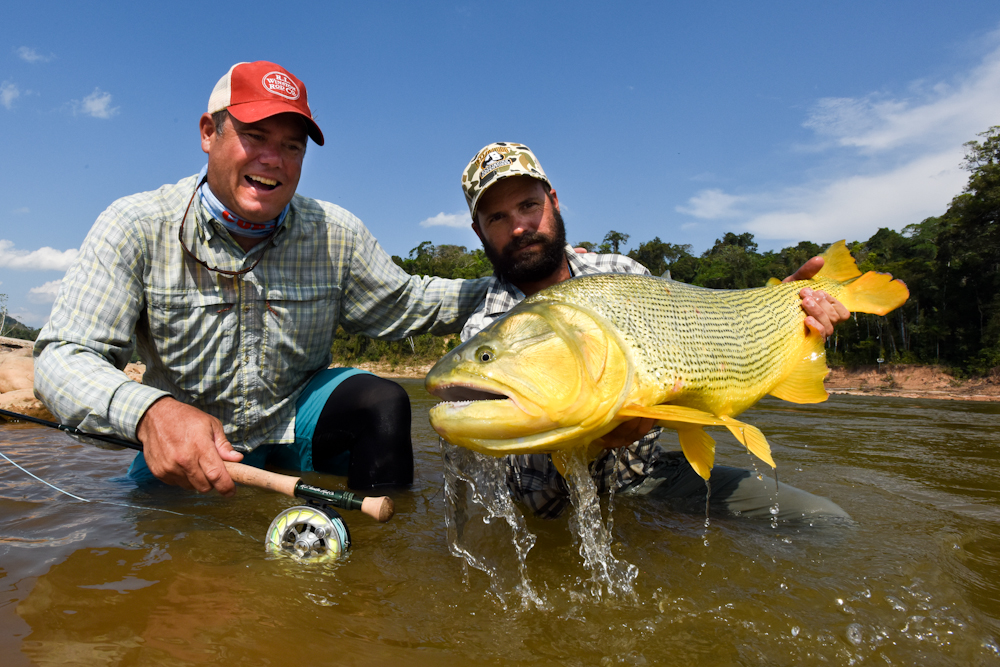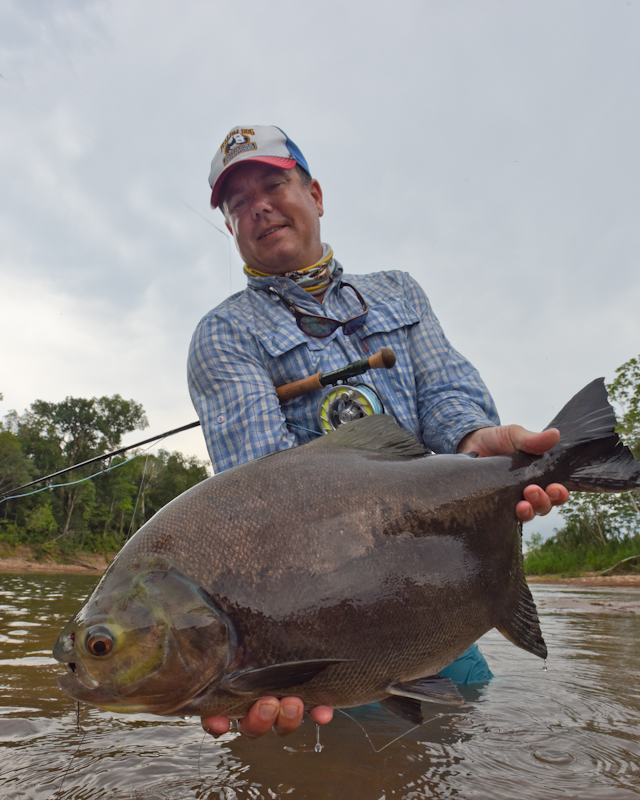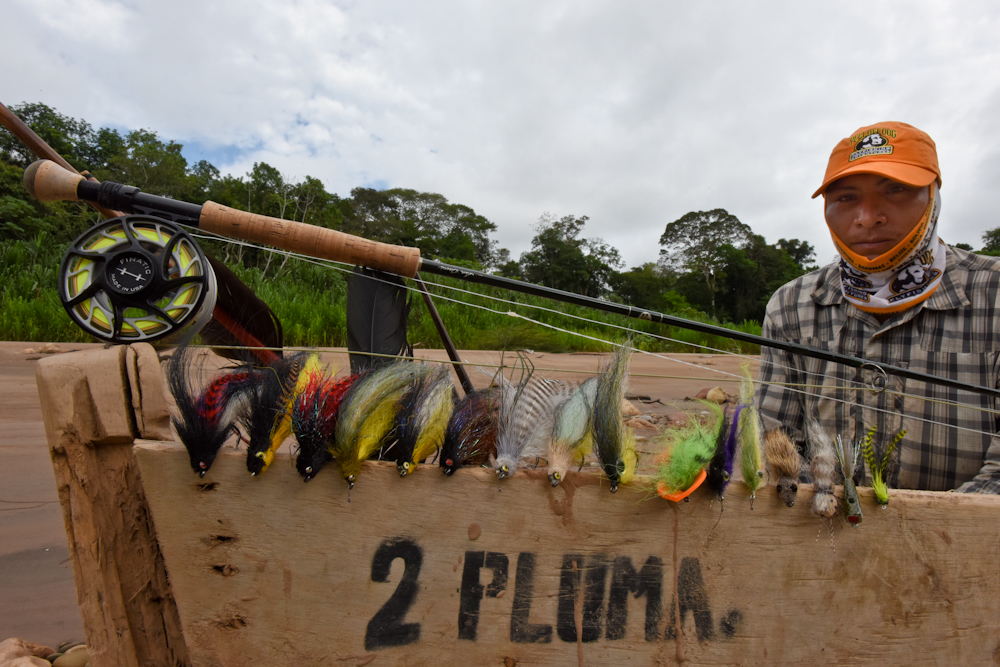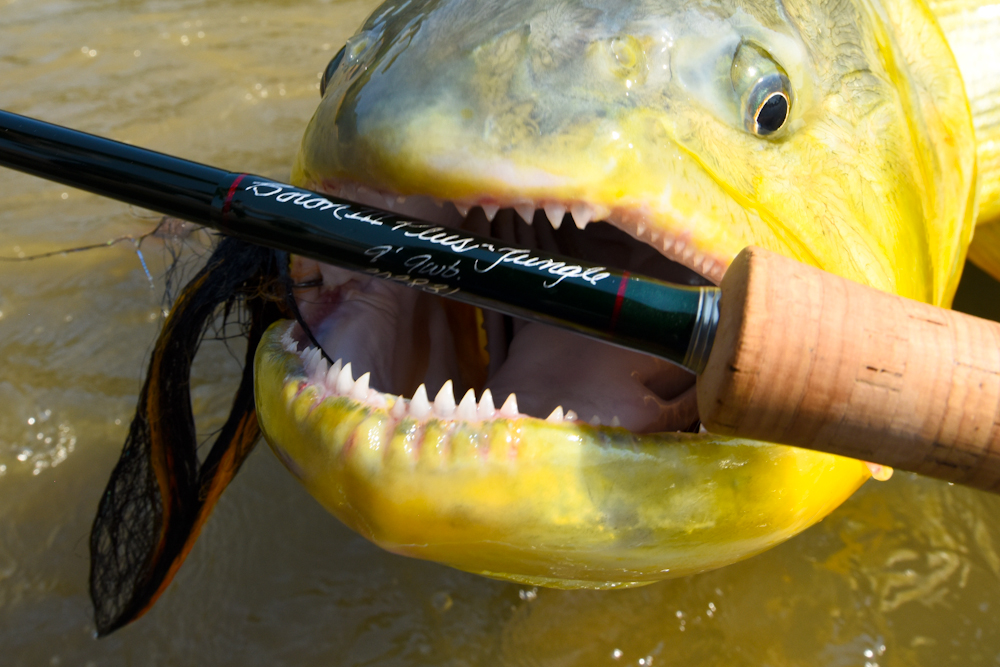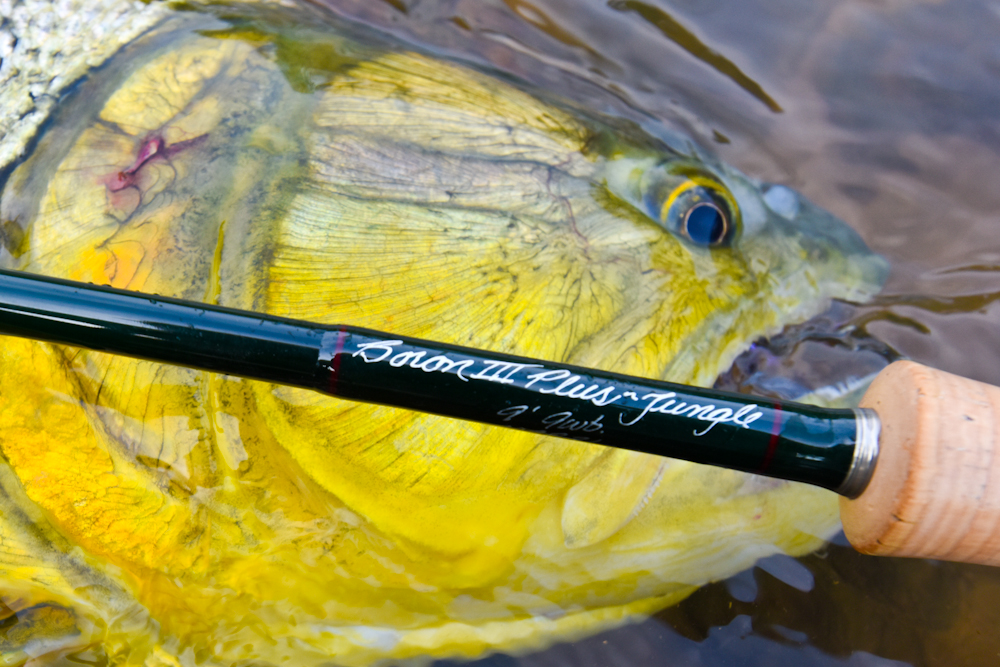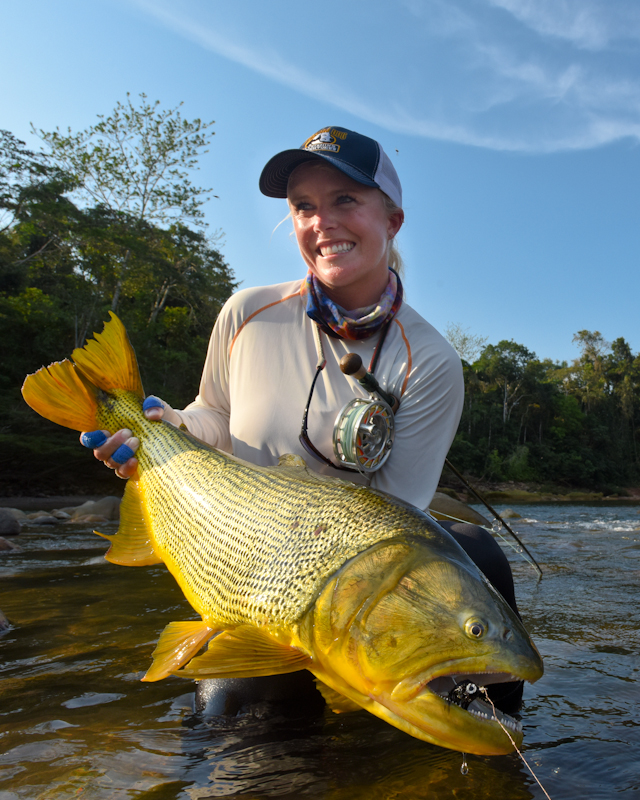Q: Where is Tsimane? How did you get there? Is it a long trip? Beautiful?
A: This unique fishery is located in the heart of the mountainous Bolivian jungle, and is the headwaters of the Amazon River in South America. I met the Yellow Dog Flyfishing Adventure guests in the Miami International Airport for the overnight flight to Santa Cruz via La Paz. The American Airlines flight is around eight hours. After clearing customs and paying for our visas we were greeted by Hugo from Untamed Angling and transferred to Los Tajibos, a luxury hotel in the center of the city. The group spent the afternoon touring the city and learning more about the fascinating cultural, historical and political landscape of Bolivia. They concluded their tour at Las Cabañas for beers and various locally-baked breads. We enjoyed a delicious dinner at a nearby traditional South American steakhouse, which was fantastic, very reasonable, and just blocks away from the hotel. The following morning, we boarded a bus for the regional airport in Santa Cruz for our fixed-wing aircraft, 1.5 hour flight to the grass landing strip next to the Omoromo Indian community. Representatives from Pluma Lodge greeted us and after the traditional distribution of candy and toys to the Chimán locals, we piled into the boats that awaited us on the banks of the lower Secure River. Depending on water condition, the run upstream is usually just over an hour to the Pluma Lodge.
Q: Is this the first time you’ve been to Bolivia?
A: This is my second trip to fish Tsimane in the western part of Bolivia. Two years ago I visited all three of Untamed Angling’s Bolivian operations: The Astunta Lodge, Agua Negra Camp, and the Pluma Lodge. Since then two of the three lodges have been washed out by massive floods during the summer months (USA winter), where water levels rise up to 20 feet. Amazingly, the staff rebuilt both operations within two months and improved the facilities – the lodges are now much higher up from the river banks! This past September I hosted two separate Yellow Dog groups over two consecutive weeks. We fished out of Pluma Lodge for both weeks. I would have preferred to mix it up between more lodges, but the guests had requested to fish out of Pluma, which I feel does offer diversity for the style of rivers. I did have the opportunity to slip away on week two to fish out of Agua Negra, and camp far upstream for a night. The fishing was insanely productive in one of the most remote and pristine rivers I have ever experienced. The photography opportunities matched the fishing.
Q: What species of fish do you target?
A: The golden dorado is the gangster of the jungle rivers. Two years ago when my first dorado attacked my fly on the upper Secure River I almost dropped the rod and ran for the hills. Setting the hook never entered my mind. These fish are explosive, look mean, and jump. They might be my favorite fresh water fish!
Then there is the permit of Bolivia – the elusive pacu, which is a shifty fish that looks like something out of a cartoon. Most fish hooked are lost due to their hard mouths and the fact that they run for cover when hooked.
The third main fly species is the yatorana, a smaller but powerful fish that looks like a whitefish on steroids. It feeds alongside dorado, so it is more of a bi-catch and not a target species. They prefer the upper reaches of the river systems. They are also rather odd looking and pull very hard for their size.
The largest fish in the river systems are catfish which can grown to 100+ pounds. They are rarely seen in the shallows where a fly may be presented to them, but the locals hand line and bait fish for them. They are sacred fish to the locals and a major food source. I have witnessed a 60+ pound catfish hand-lined by our boatmen during a lunch time fishing contest. We set-up a heavy spinning rod outfit with bait and the local boatmen had a string, hook, and the same bait. Not only did they kick our ass by hooking a fish within minutes, but they had to swim into an undercut bank to wrestle the fish up the surface. It is an amazing process to watch.
Q: Describe your typical day in the Jungle. How different is it from other freshwater or saltwater destinations you have visited? Do you need different flies, equipment, clothes, etc?
A: Everything in the jungle is very different when compared to a typical fishing excursion. The conditions are extreme, which sounds like a cheesy cliche, but could not be any closer to the truth when fishing for dorado in Bolivia – between navigating the rapids, the varying weather and water conditions, and dealing with a fish that can destroy a fly rod in one shake of its head. Traveling to Bolivia demands thorough and detailed pre-trip preparation. Maybe it also feels extreme because you are so remote while fishing in the middle of a vast jungle. As you scale a high bank or navigate a massive boulder garden, you are constantly considering the ramifications of a broken ankle or worse. How the hell would you get out of here? Global Rescue is mandatory. This is an area you do not want to show up unprepared. Boots, clothing, tackle, flies, fly lines, reels, pliers, and especially rods are all specialized for this trip. There is no other destination in the world like Tsimane!
I have some of the flies custom tied for our Yellow Dog anglers, since they are so specialized. The larger patterns are difficult to locate in your local fly shop or even online. The dorado’s small razor-sharp teeth shred flies and most “store bought” bugs fall apart after one fish. A properly tied fly with some love (or zap goo), can result in catching numerous fish off one fly. This can save you big bucks, since the big flies go for $12 each! I spent months tying flies for my hosted trips. I love handing them out to the Yellow Dog guests when they need that specialized fly! I always travel to obscure destinations with a fly tying kit, as you never know what fly you might need. In Bolivia this is imperative, because the spun deer hair muddler style head is often the first part of the fly to fall apart. You can easily re-spin that part of the fly each evening, thus revitalizing your bug for the next day. In fact two years ago, we had an angler use the same fly most of the week. Each evening I would refresh it for him.
During the beginning part of the trip the water was so low that many of the flies we had were too big and heavy. Later in week, two those flies were perfect because we got some rain. For this reason it is imperative to have a wide range of colors, sized flies, and weights for the varying conditions. The single most important factor in a dorado fly is the actual hook. It must be strong and sharp or you will lose all your big fish. These fish break or open hooks more than anywhere else I have ever fished. This is not just because their powerful crushing jaws, razor sharp teeth, but also because you must often “death grip” the fish before they run into a log jam.
Q: We hear how powerful these jungle fish are. Can you help us understand just how different they are from other freshwater fish? Teeth? The fight? Easy to land? Sight fishing?
A: Golden Dorado behave similarly to brown trout, because of where they lay in wait to ambush prey. If I have trouble locating dorado I put on my “brown trout thinking cap” and typically find them based on water depth, temperature, and clarity. Dorado differ from a trout with their razor sharp teeth and massive heads. They remind me of a Giant Trevally because they hunt baitfish in shallow water with reckless abandon. Being migratory fish they can navigate extreme shallow, swift, and turbulent water. You will find these fish feeding in dark and muddy water where blind casting with big, dark colored flies is the program. Then conversely in the upper reaches of the drainages sight fishing and stalking Kiwi-style is the name of the game. This is what draws most anglers to Tsimane. Crystal clear creeks with large aggressive fish can get even the most traveled angler excited. Long casts, subtle presentations, and Enrico Puglisi-style baitfish patterns are the key to success in the upper rivers like the Itizisma, Upper Pluma, Secure, and Agua Negra Rivers. Only hearty anglers who are ready to hike through the jungle and large rocks are fit for these beasts. The lower rivers are best suited for those looking to have low impact days where you can mainly fish from the boats, and wadefish along sand beach banks.
Schools of dorado will gang up on the baitfish (sabalo) like a pack of wolves hunting elk, or marlin corralling bait. Once the baitfish are pushed into the shallows, the feeding frenzy ensues with baitfish jumping everywhere and the dorado in hot pursuit. You can see these frenzies from hundreds of yards away, due to the whitewater and splashing as the dorado slice into the schools of bait. Often you will see dorado swimming with half their bodies out of the water. The ideal situation for the angler is to be within casting distance of these murderous buffets. Having the ability to make a quick presentation is paramount, as these frenzies often do not last long. The Winston Jungle Rod is the prefect tool for minimal false casts while shooting a large clumsy fly. Get your baitfish imitation fly anywhere in front of a dorado and you are tight. You will literally see dorado with their eyes out of the water searching for baitfish, or jumping through a boulder garden chasing sabalo. On one occasion I could hear the dorado’s skulls bashing into rocks as they hunted. I have seen a frenzy over a mud flat, where the dorado got kinda lost in the stirred up muddy water, so they just stopped like a laid-up tarpon. Their backs were out of the water and reminded me of redfish. We threw baitfish flies with no luck, because they could not see the fly. Then we re-tied with a popper and the fish hammered the fly, because they heard a loud popping disturbance.
Once a dorado is hooked the real work or fun begins. They pull hard, jump, and ultimately run for cover. Since we were fishing 40 pound test you can really lean on the fish. This is why a premium fly rod is imperative. Last time I was in Bolivia we had blown up over eight rods between six anglers in a week. This year I fished only one rod all week and did not back-off at all. The Winston Boron III Plus Jungle rods are perfectly designed for this fishery. If you cannot stop (and I mean STOP) a 25 pound dorado with 40 pound test before it swims into an intricate log jam you will lose half your fish. Maximum pressure, serious leverage by incorporating the “down and dirty” fish fighting technique, and staying close to the fish are all vital to success. Again, the rod you fish also needs to shoot line quickly. Since you are also blind casting all day, minimal false casting is key to making it through the day without tiring. The oversized guides on the Jungle rod enable aggressively tapered lines to shoot further with minimal false casts. When you land a Golden Dorado and want to hold it for a photo…….be careful. They can bite off your finger in a flash. We had one angler get nipped and it dislodged his finger nail and laid a serious gash on both sides of his index finger.
Pacu are fished in slow, deep pools below trees with long vines that drop flowers, nuts and fruit into the pool. These delectables are their main for source of food, but they have also been known to take a smaller baitfish fly. On our last day of fishing during the first week, we had some rain, wind, and clouds. We found the pacu cruising the shallow riffles, which I had never experienced. The guide explained this was due to the wind knocking lots of food out of the trees. We fished smaller brightly colored tarpon flies and presented our flies exactly as if the pacu were permit. Hit ’em on the nose and they ate. This was our best day of fishing over the two weeks. It was super fun following Captain Scott Owens from St. Simmons Island, GA around shooting photos. He is one of the top guides in the Georgia for reds and tarpon. He is an awesome angler and being a saltwater angler is a huge advantage, because of the strip set and long casts. I got a few nice fish that day, but shooting photos was just as much fun!
Q: Other than the Tsimane staff who helped us in designing and testing the rods, you are one of our first Pro Advisors to visit Bolivia and use the new Boron III Plus Jungle Rods. How did they perform, how different are they, and specifically what about them did you like for this kind of fishing? Why bring a jungle fly rod instead of other, standard saltwater rods?
A: Like I mentioned above, I’m very impressed by the Jungle rod series. Many rods today are fine casting tools, or fight fish well, but very few do both. I feel this has always been the strength of the Boron series from Winston and why I fish them exclusively. The last thing I want in a fly rod is an eight weight that feels like a six. Lighter rods are not necessarily better! When you create such a light rod it must be ultra-fast to support the weight of the matched line. This creates a “broom stick” feel in the action until the angler loads 60 feet of line. Most fish are caught within 50 feet, so having a rod that is powerful is important for wind and big flies, but it must also have the ability to deliver a fly in-close with finesse. This is where the Boron and graphite combination of Winston Boron III rods excels. You have the power in the lower sections of the blanks and then a more responsive tip section that allows for a smooth feel. While the new Boron III Plus rods are quite fast, the unique taper of the blank does feel more comfortable for me personally than many other “fast rods”. I like to feel the upper section of the rod flex and react as I alter my stroke for different conditions and tactics.
The Jungle rod is a no-brainer for anyone fishing for dorado, pacu, peacock bass, backcountry tarpon, snook, pike, muskies, large and small mouth bass, tigerfish, GT’s, and any other species where you are throwing large flies for big fish.
Q: How did everyone do? Would you expect to land a few every day? Is the fishing weather-dependent? Does the rain help?
A: Water conditions do dictate where you will locate Golden Dorado, as with any type of angling situation. There are definitely certain conditions and seasons at Tsimane that are better suited for beginner anglers. As the rivers drop and clear, the fish become more wary and spooky……unless they are in a feeding frenzy of course. Like any destination, angler ability and current conditions plays a major role in how many fish are landed. The rivers are for the most part pretty intimate or small, so making long hero casts is not the separating factor between those who slam ’em or those who just get a few. The key to increasing your fish count is the ability to read the water, make a quick presentation, and be ready to strip set. The innate ability to know how to strip the fly is also another key factor to success. More often than not, a long and slow strip gets ‘em better than fast stripping, which is what most anglers do instinctively because the speed of the dorado. The bite from a Golden Dorado is often so explosive that anglers are surprised and instinctively trout set. Those from the world of saltwater fly fishing have a distinct advantage over trout anglers in Bolivia, because they are used to the correct strip set and fighting big fish quickly.
Precipitation might be the single most important factor in your trip. The good news is that you can catch fish in pretty much any water condition. These fish will feed in chocolate milk colored water. Often fishing the top water is the best method in dark water, so that the fish can feel the fly poppin’ on the surface. The current river conditions will dictate your angling technique and where you fish. You can beat the odds by choosing the time of year you fish in Tsimane. At Yellow Dog, we have fished every season and are happy to advise on the most productive time of year to fish in the jungles of Bolivia.
Q: What was your favorite moment of the trip?
A: After the first full day of fishing when each and every Yellow Dog angler had landed their first Golden Dorado! There were lots of smiles and stories that night at dinner.


